Novel Trimethoprim-Based Metal Complexes and Nanoparticle Functionalization: Synthesis, Structural Analysis, and Anticancer Properties
Abstract
:1. Introduction
2. Results and Discussion
2.1. HD Description
2.2. Complex Description
2.2.1. FTIR Spectra
2.2.2. 1H NMR
2.2.3. Thermal Analysis
2.2.4. Magnetic Moment and UV-Visible Spectra
2.2.5. X-Ray Diffraction Studies (XRD)
2.3. Characterization of the Nanoparticles
2.3.1. UV–Vis Spectra for ZnONPs
2.3.2. UV–Vis Spectral for GNPs
2.3.3. TEM
2.3.4. X-Ray Diffraction Studies (XRD)
2.3.5. FTIR
2.4. Computational Study
2.4.1. Molecular Mechanical Method (MM2)
2.4.2. The Surface Properties of HD
2.4.3. The DFT for TMP and HD
- Changes between ground states outline local, non-local, and global hardness/softness functions.
- Soft-soft and hard-hard interactions are favored, with interactions progressing toward maximum hardness under chemical potential.
- These principles aid in understanding molecular behavior and response to different chemicals [52].
2.4.4. Target-Ligand Interaction Prediction
2.4.5. Biological Availability Estimation
2.4.6. Pharmacokinetic Properties
2.4.7. Quantitative Structure-Activity Relationship (QSAR)
D-QSAR Model
Principal Component Analysis (PCA)
2.4.8. Prediction of Mechanical Properties of Nanoparticles
2.4.9. Molecular Docking
Docking of 5-Fluorouracil and Trimethoprim with Caspase-3 (PDB Code: 3GJQ)
Docking of HD and Its Complexes with Caspase-3 (PDB Code: 3GJQ)
2.5. In Vitro Antitumor Activity
2.5.1. In Vitro Anticancer Activity by MTT Assay
2.5.2. Quantitative Real-Time PCR
3. Experimental
3.1. Chemicals and Instrumentation
3.2. Synthesis
3.2.1. The HD Synthesis
3.2.2. The Complex Synthesis
3.2.3. ZnO Nanoparticles
3.2.4. The Au Nanoparticles
3.2.5. Functionalization @ZnO or @Au Nanoparticles
3.3. In Silico Studies
3.4. Antitumor Activity Evaluation
3.5. Quantitative Real-Time PCR
4. Conclusions
Supplementary Materials
Author Contributions
Funding
Institutional Review Board Statement
Informed Consent Statement
Data Availability Statement
Acknowledgments
Conflicts of Interest
Correction Statement
References
- Ali, E.-S.; Abeer, O.; Sama, A.-A.; Omar, A.-S. Anti-Cancer and Anti-Microbial Activity Studies of Some Complexes of Trimethoprim. J. Cancer Res. Updates 2013, 2, 14–20. [Google Scholar] [CrossRef]
- Ott, I.; Gust, R. Non platinum metal complexes as anti-cancer drugs. Arch. Pharm. Int. J. Pharm. Med. Chem. 2007, 340, 117–126. [Google Scholar] [CrossRef]
- Abbas, A.M.; Aboelmagd, A.; Kishk, S.M.; Nasrallah, H.H.; Boyd, W.C.; Kalil, H.; Orabi, A.S. A Novel Ibuprofen Derivative and Its Complexes: Physicochemical Characterization, DFT Modeling, Docking, In Vitro Anti-Inflammatory Studies, and DNA Interaction. Molecules 2022, 27, 7540. [Google Scholar] [CrossRef]
- Abbas, A.M.; Fisal, S.R.; Orabi, A.S. Novel β-lactam antibiotic derivative and its complexes: DFT, frontier energy levels, DNA interaction, docking, physicochemical and antimicrobial properties. J. Mol. Struct. 2020, 1218, 128487. [Google Scholar] [CrossRef]
- Abbas, A.M.; Fisal, S.R.; Orabi, A.S. Enhancement of the biochemical activity of some market antibiotics by chemical modification: Synthesis, characterization, and biochemical evaluation. J. Chin. Chem. Soc. 2021, 68, 131–149. [Google Scholar] [CrossRef]
- Abbas, A.M.; Fisal, S.R.; Radwan, A.; Makhlouf, M.; Orabi, A.S. Novel action for ampicillin derivative and its complexes: Physicochemical, thermal analysis, DNA interaction, docking with FabH protein, in silico, and in vitro studies. J. Mol. Liq. 2022, 351, 118333. [Google Scholar] [CrossRef]
- Scozzafava, A.; Menabuoni, L.; Mincione, F.; Mincione, G.; Supuran, C.T. Carbonic anhydrase inhibitors: Synthesis of sulfonamides incorporating dtpa tails and of their zinc complexes with powerful topical antiglaucoma properties. Bioorg. Med. Chem. Lett. 2001, 11, 575–582. [Google Scholar] [CrossRef] [PubMed]
- Walsh, C. Enabling the chemistry of life. Nature 2001, 409, 226–231. [Google Scholar] [CrossRef]
- Bertini, I.; Gray, H.B.; Lippard, S.J.; Valentine, J.S. Bioinorganic Chemistry; University Science Books: Mill Valley, CA, USA, 1994. [Google Scholar]
- Mahmoud, M.A.; Sallam, S.A.; Abdelrahman, R.B.; Abbas, A.M. Studies of the molecular docking, antibacterial, antifungal, and DNA interaction of mixed-ligand Ni (II) complexes with gabapentin or pregabalin and diimine coligands. Inorg. Chim. Acta 2024, 564, 121959. [Google Scholar] [CrossRef]
- Ajibade, P.A.; Idemudia, O.G. Synthesis, Characterization, and Antibacterial Studies of Pd(II) and Pt(II) Complexes of Some Diaminopyrimidine Derivatives. Bioinorg. Chem. Appl. 2013, 2013, 549549. [Google Scholar] [CrossRef]
- Demirezen, N.; Tarınç, D.; Polat, D.; Çeşme, M.; Gölcü, A.; Tümer, M. Synthesis of trimethoprim metal complexes: Spectral, electrochemical, thermal, DNA-binding and surface morphology studies. Spectrochim. Acta Part A Mol. Biomol. Spectrosc. 2012, 94, 243–255. [Google Scholar] [CrossRef] [PubMed]
- Ahmed, M.Z.; Habib, U. DFT studies of temperature effect on coordination chemistry of Cu(II)-trimethoprim complexes. J. Coord. Chem. 2018, 71, 1102–1113. [Google Scholar] [CrossRef]
- Sekhon, B.S.; Randhawa, H.S.; Sahai, H.K. On the coordinating behaviour of trimethoprim towards some metal ions. Synth. React. Inorg. Met.-Org. Chem. 1999, 29, 309–321. [Google Scholar]
- Albedair, L.A. Iron(III), gold(III), platinum(IV) and palladium(II) trimethoprim drug complexes: Synthesis, spectroscopic, morphological and anticancer assessments. Rev. Roum. Chim. 2021, 65, 1145–1152. [Google Scholar] [CrossRef]
- Abdussalam-Mohammed, W. Comparison of chemical and biological properties of metal nanoparticles (Au, Ag), with metal oxide nanoparticles (ZnO-NPs) and their applications. Adv. J. Chem. Sect. A 2020, 3, 111–236. [Google Scholar]
- Achilonu, C.C.; Kumar, P.; Swart, H.C.; Roos, W.D.; Marais, G.J. Zinc Oxide: Gold Nanoparticles (ZnO: Au NPs) Exhibited Antifungal Efficacy Against Aspergillus niger and Aspergillus candidus. BioNanoScience 2024, 14, 799–813. [Google Scholar] [CrossRef]
- Anjum, S.; Hashim, M.; Malik, S.A.; Khan, M.; Lorenzo, J.M.; Abbasi, B.H.; Hano, C. Recent advances in zinc oxide nanoparticles (ZnO NPs) for cancer diagnosis, target drug delivery, and treatment. Cancers 2021, 13, 4570. [Google Scholar] [CrossRef]
- Siddique, S.; Chow, J.C.L. Gold Nanoparticles for Drug Delivery and Cancer Therapy. Appl. Sci. 2020, 10, 3824. [Google Scholar] [CrossRef]
- Kajani, A.A.; Bordbar, A.-K.; Esfahani, S.H.Z.; Razmjou, A. Gold nanoparticles as potent anticancer agent: Green synthesis, characterization, and in vitro study. RSC Adv. 2016, 6, 63973–63983. [Google Scholar]
- ElShaer, A.; Hanson, P.; Worthington, T.; Lambert, P.; Mohammed, A.R. Preparation and Characterization of Amino Acids-Based Trimethoprim Salts. Pharmaceutics 2012, 4, 179–196. [Google Scholar] [CrossRef]
- Florey, K.; Brittain, H.G.; Prankerd, R.J. Analytical Profiles of Drug Substances; Brittain, H.G., Ed.; Academic Press Inc.: Cambridge, MA, USA, 1993. [Google Scholar]
- Ungurean, A.; Leopold, N.; David, L.; Chiş, V. Vibrational spectroscopic and DFT study of trimethoprim. Spectrochim. Acta Part A Mol. Biomol. Spectrosc. 2013, 102, 52–58. [Google Scholar] [CrossRef]
- Subashchandrabose, S.; Krishnan, A.R.; Saleem, H.; Thanikachalam, V.; Manikandan, G.; Erdogdu, Y. FT-IR, FT-Raman, NMR spectral analysis and theoretical NBO, HOMO–LUMO analysis of bis(4-amino-5-mercapto-1,2,4-triazol-3-yl)ethane by ab initio HF and DFT methods. J. Mol. Struct. 2010, 981, 59–70. [Google Scholar] [CrossRef]
- Socrates, G. Infrared and Raman Characteristic Group Frequencies: Tables and Charts; John Wiley & Sons: Hoboken, NJ, USA, 2004; p. 386. [Google Scholar]
- Puviarasan, N.; Arjunan, V.; Mohan, S. FT-IR and FT-Raman Studies on 3-Aminophthalhydrazide and N-Aminophthalimide. Turk. J. Chem. 2002, 26, 4. [Google Scholar]
- Wang, L.; Cao, C.; Cao, C. Substituent effects on the stretching vibration of C═N in multi-substituted benzylideneanilines. J. Phys. Org. Chem. 2019, 32, e3969. [Google Scholar] [CrossRef]
- Manius, G.J. Trimethoprim. In Analytical Profiles of Drug Substances; Elsevier: Amsterdam, The Netherlands, 1978; Volume 7, pp. 445–475. [Google Scholar]
- Montazerozohori, M.; Musavi, S.A.; Masoudiasl, A.; Naghiha, A.; Dusek, M.; Kucerakova, M. Synthesis, spectral, crystal structure, thermal behavior, antimicrobial and DNA cleavage potential of two octahedral cadmium complexes: A supramolecular structure. Spectrochim. Acta Part A Mol. Biomol. Spectrosc. 2015, 137, 389–396. [Google Scholar] [CrossRef] [PubMed]
- Bravo, A.; Anacona, J.R. Synthesis and characterization of metal complexes with ampicillin. J. Coord. Chem. 1998, 44, 173–182. [Google Scholar] [CrossRef]
- El-Gamel, N.E.A. Metal chelates of ampicillin versus amoxicillin: Synthesis, structural investigation, and biological studies. J. Coord. Chem. 2010, 63, 534–543. [Google Scholar] [CrossRef]
- Abbas, A.; Salem, H.; Orabi, A. Synthesis, characterization, in vitro and in silico assessment of novel diclofenac derivative metal complexes. J. Mol. Struct. 2024, 1318, 139191. [Google Scholar] [CrossRef]
- Barszcz, B. Coordination properties of didentate N,O heterocyclic alcohols and aldehydes towards Cu(II), Co(II), Zn(II) and Cd(II) ions in the solid state and aqueous solution. Coord. Chem. Rev. 2005, 249, 2259–2276. [Google Scholar] [CrossRef]
- Yoshimura, T.; Miyake, C.; Imoto, S. Ultraviolet and Infrared Spectra of Cupferron and Neocupferron. Bull. Chem. Soc. Jpn. 1972, 45, 1424–1430. [Google Scholar] [CrossRef]
- Tong, M.M.; Brewer, D.G. Nature of the Coordination Bond in Metal Complexes of Substituted Pyridine Derivatives. VI. Electronic Spectra of Some Complexes of Copper(II). Can. J. Chem. 1971, 49, 102–104. [Google Scholar] [CrossRef]
- Dholakiya, P.P.; Patel, M.N. Preparation, magnetic, spectral, and biocidal studies of some transition metal complexes with 3, 5-dibromosalicylideneaniline and neutral bidentate ligands. Synth. React. Inorg. Met.-Org. Chem. 2002, 32, 819–829. [Google Scholar] [CrossRef]
- Al-Amiery, A.A.; Al-Majedy, Y.K.; Abdulreazak, H.; Abood, H. Synthesis, Characterization, Theoretical Crystal Structure, and Antibacterial Activities of Some Transition Metal Complexes of the Thiosemicarbazone (Z)-2-(pyrrolidin-2-ylidene)hydrazinecarbothioamide. Bioinorg. Chem. Appl. 2011, 2011, 483101. [Google Scholar] [CrossRef]
- Altomare, A.; Camalli, M.; Cuocci, C.; Giacovazzo, C.; Moliterni, A.; Rizzi, R. EXPO2009: Structure solution by powder data in direct and reciprocal space. J. Appl. Crystallogr. 2009, 42, 1197–1202. [Google Scholar] [CrossRef]
- Sharmila, G.; Thirumarimurugan, M.; Muthukumaran, C. Green synthesis of ZnO nanoparticles using Tecoma castanifolia leaf extract: Characterization and evaluation of its antioxidant, bactericidal and anticancer activities. Microchem. J. 2019, 145, 578–587. [Google Scholar] [CrossRef]
- Singh, G.; Babele, P.K.; Kumar, A.; Srivastava, A.; Sinha, R.P.; Tyagi, M.B. Synthesis of ZnO nanoparticles using the cell extract of the cyanobacterium, Anabaena strain L31 and its conjugation with UV-B absorbing compound shinorine. J. Photochem. Photobiol. B Biol. 2014, 138, 55–62. [Google Scholar] [CrossRef] [PubMed]
- Okamoto, T.; Yamaguchi, I. Optical Absorption Study of the Surface Plasmon Resonance in Gold Nanoparticles Immobilized onto a Gold Substrate by Self-Assembly Technique. J. Phys. Chem. B 2003, 107, 10321–10324. [Google Scholar] [CrossRef]
- Henglein, A. Physicochemical properties of small metal particles in solution: “microelectrode” reactions, chemisorption, composite metal particles, and the atom-to-metal transition. J. Phys. Chem. 1993, 97, 5457–5471. [Google Scholar] [CrossRef]
- Hasan, M.; Bethell, D.; Brust, M. The fate of sulfur-bound hydrogen on formation of self-assembled thiol monolayers on gold: 1H NMR spectroscopic evidence from solutions of gold clusters. J. Am. Chem. Soc. 2002, 124, 1132–1133. [Google Scholar] [CrossRef]
- Link, S.; El-Sayed, M.A. Spectral properties and relaxation dynamics of surface plasmon electronic oscillations in gold and silver nanodots and nanorods. J. Phys. Chem. B 1999, 103, 8410–8426. [Google Scholar] [CrossRef]
- Rattanawongwiboon, T.; Soontaranon, S.; Hemvichian, K.; Lertsarawut, P.; Laksee, S.; Picha, R. Study on particle size and size distribution of gold nanoparticles by TEM and SAXS. Radiat. Phys. Chem. 2022, 191, 109842. [Google Scholar] [CrossRef]
- Mayoral, Á.; Agúndez, J.; Pascual-Valderrama, I.M.; Pérez-Pariente, J. Generation of gold nanoparticles according to procedures described in the eighteenth century. Gold Bull. 2014, 47, 161–165. [Google Scholar] [CrossRef]
- Chandrappa, K.G.; Venkatesha, T.V.; Vathsala, K.; Shivakumara, C. A hybrid electrochemical–thermal method for the preparation of large ZnO nanoparticles. J. Nanopart. Res. 2010, 12, 2667–2678. [Google Scholar] [CrossRef]
- Mitra, P.; Mondal, S. Structural and Morphological Characterization of ZnO thin Films Synthesized by SILAR. Prog. Theor. Appl. Phys. 2013, 1, 17–31. [Google Scholar]
- Hisaindee, S.; Al-Kaabi, L.; Ajeb, S.; Torky, Y.; Iratni, R.; Saleh, N.i.; AbuQamar, S.F. Antipathogenic effects of structurally-related Schiff base derivatives: Structure–activity relationship. Arab. J. Chem. 2015, 8, 828–836. [Google Scholar] [CrossRef]
- Tyagi, P.; Tyagi, M.; Agrawal, S.; Chandra, S.; Ojha, H.; Pathak, M. Synthesis, characterization of 1,2,4-triazole Schiff base derived 3D-metal complexes: Induces cytotoxicity in HepG2, MCF-7 cell line, BSA binding fluorescence and DFT study. Spectrochim. Acta Part A Mol. Biomol. Spectrosc. 2017, 171, 246–257. [Google Scholar] [CrossRef]
- Rauf, A.; Shah, A.; Munawar, K.S.; Khan, A.A.; Abbasi, R.; Yameen, M.A.; Khan, A.M.; Khan, A.R.; Qureshi, I.Z.; Kraatz, H.-B.; et al. Synthesis, spectroscopic characterization, DFT optimization and biological activities of Schiff bases and their metal (II) complexes. J. Mol. Struct. 2017, 1145, 132–140. [Google Scholar] [CrossRef]
- Gázquez, J.L. Hardness and softness in density functional theory. In Chemical Hardness; Sen, K.D., Ed.; Springer: Berlin/Heidelberg, Germany, 1993; pp. 27–43. [Google Scholar]
- Cheng, T.; Zhao, Y.; Li, X.; Lin, F.; Xu, Y.; Zhang, X.; Li, Y.; Wang, R.; Lai, L. Computation of Octanol−Water Partition Coefficients by Guiding an Additive Model with Knowledge. J. Chem. Inf. Model. 2007, 47, 2140–2148. [Google Scholar] [CrossRef]
- Daina, A.; Zoete, V. A BOILED-Egg To Predict Gastrointestinal Absorption and Brain Penetration of Small Molecules. ChemMedChem 2016, 11, 1117–1121. [Google Scholar] [CrossRef]
- Wildman, S.A.; Crippen, G.M. Prediction of Physicochemical Parameters by Atomic Contributions. J. Chem. Inf. Comput. Sci. 1999, 39, 868–873. [Google Scholar] [CrossRef]
- Veber, D.F.; Johnson, S.R.; Cheng, H.-Y.; Smith, B.R.; Ward, K.W.; Kopple, K.D. Molecular Properties That Influence the Oral Bioavailability of Drug Candidates. J. Med. Chem. 2002, 45, 2615–2623. [Google Scholar] [CrossRef] [PubMed]
- Brito, M.A.d. Pharmacokinetic study with computational tools in the medicinal chemistry course. Braz. J. Pharm. Sci. 2011, 47, 797–805. [Google Scholar] [CrossRef]
- Pires, D.E.; Blundell, T.L.; Ascher, D.B. pkCSM: Predicting small-molecule pharmacokinetic and toxicity properties using graph-based signatures. J. Med. Chem. 2015, 58, 4066–4072. [Google Scholar] [CrossRef]
- Frimayanti, N. 2D, 3D-QSAR, and pharmacophore studies on thiazolidine-4-carboxylic acid derivatives as neuraminidase inhibitors in H3N2 influenza virus. Med. Chem. Res. 2014, 23, 1447–1453. [Google Scholar] [CrossRef]
- Karthikeyan, M.; Vyas, R.; Karthikeyan, M.; Vyas, R. Open-source tools, techniques, and data in chemoinformatics. In Practical Chemoinformatics; Springer: Berlin/Heidelberg, Germany, 2014; pp. 1–92. [Google Scholar]
- Ferrara, P.; Apostolakis, J.; Caflisch, A. Evaluation of a fast implicit solvent model for molecular dynamics simulations. Proteins Struct. Funct. Bioinform. 2002, 46, 24–33. [Google Scholar] [CrossRef]
- Ertl, P.; Rohde, B.; Selzer, P. Fast calculation of molecular polar surface area as a sum of fragment-based contributions and its application to the prediction of drug transport properties. J. Med. Chem. 2000, 43, 3714–3717. [Google Scholar] [CrossRef] [PubMed]
- Xu, S.-P.; Sun, G.-P.; Shen, Y.-X.; Wei, W.; Peng, W.-R.; Wang, H. Antiproliferation and apoptosis induction of paeonol in HepG2 cells. World J. Gastroenterol. WJG 2007, 13, 250–256. [Google Scholar] [CrossRef] [PubMed]
- Xu, T.; Guo, P.; Pi, C.; He, Y.; Yang, H.; Hou, Y.; Feng, X.; Jiang, Q.; Wei, Y.; Zhao, L. Synergistic Effects of Curcumin and 5-Fluorouracil on the Hepatocellular Carcinoma In vivo and vitro through regulating the expression of COX-2 and NF-κB. J. Cancer 2020, 11, 3955–3964. [Google Scholar] [CrossRef]
- Xu, W.; Pan, Y.; Wang, H.; Li, H.; Peng, Q.; Wei, D.; Chen, C.; Zheng, J. Synthesis and Evaluation of New Pyrazoline Derivatives as Potential Anticancer Agents in HepG-2 Cell Line. Molecules 2017, 22, 467. [Google Scholar] [CrossRef]
- Lange, J.H.; Reinders, J.-H.; Tolboom, J.T.; Glennon, J.C.; Coolen, H.K.; Kruse, C.G. Principal component analysis differentiates the receptor binding profiles of three antipsychotic drug candidates from current antipsychotic drugs. J. Med. Chem. 2007, 50, 5103–5108. [Google Scholar] [CrossRef]
- Ringnér, M. What is principal component analysis? Nat. Biotechnol. 2008, 26, 303–304. [Google Scholar] [CrossRef] [PubMed]
- Song, L.; Liu, W.; Xin, F.; Li, Y. “Materials Studio” Simulation Study of the Adsorption and Polymerization Mechanism of Sodium Silicate on Active Silica Surface at Different Temperatures. Int. J. Metalcast. 2021, 15, 1091–1098. [Google Scholar] [CrossRef]
- Tran, N.V.; Tieu, A.K.; Zhu, H.; Ta, H.T.T.; Ta, T.D.; Le, H.M. First-Principles Study of the Adsorption and Depolymerization Mechanisms of Sodium Silicate on Iron Surfaces at High Temperature. J. Phys. Chem. C 2018, 122, 20827–20840. [Google Scholar] [CrossRef]
- Liu, H.; Song, L. Materials Studio simulation for the adsorption properties of CO2 molecules at the surface of sodium silicate and potassium silicate solution under different pressure conditions. Int. J. Met. 2022, 16, 242–251. [Google Scholar] [CrossRef]
- Fan, L.; Luo, C.; Li, X.; Lu, F.; Qiu, H.; Sun, M. Fabrication of novel magnetic chitosan grafted with graphene oxide to enhance adsorption properties for methyl blue. J. Hazard. Mater. 2012, 215, 272–279. [Google Scholar] [CrossRef]
- Li, L.; Larsen, A.H.; Romero, N.A.; Morozov, V.A.; Glinsvad, C.; Abild-Pedersen, F.; Greeley, J.; Jacobsen, K.W.; Nørskov, J.K. Investigation of Catalytic Finite-Size-Effects of Platinum Metal Clusters. J. Phys. Chem. Lett. 2013, 4, 222–226. [Google Scholar] [CrossRef] [PubMed]
- Teobaldi, G.; Zerbetto, F. Adsorption of organic molecules on gold electrodes. J. Phys. Chem. C 2007, 111, 13879–13885. [Google Scholar] [CrossRef]
- RCSB Protein Data Bank. PDB—5IKT: The Structure of Tolfenamic Acid Bound to Human Cyclooxygenase-2. Available online: https://www.rcsb.org/structure/5IKT (accessed on 21 April 2025).
- Abbas, A.M.; Nasrallah, H.H.; Aboelmagd, A.; Kishk, S.M.; Boyd, W.C.; Kalil, H.; Orabi, A.S. Design, Synthesis, Anti-Inflammatory Activity, DFT Modeling and Docking Study of New Ibuprofen Derivatives. Int. J. Mol. Sci. 2024, 25, 3558. [Google Scholar] [CrossRef]
- Alnakib, N.; Abdel-Hamid, N.; El-Senduny, F.; EL-Gharieb, M. Assessment of Alpha-fetoprotein levels and the effect of 5-Fluorouracil on Cytotoxicity of HepG2 cell line. Alfarama J. Basic Appl. Sci. 2022, 3, 210–219. [Google Scholar] [CrossRef]
- Wu, X.-X.; Kakehi, Y.; Mizutani, Y.; Lu, J.; Terachi, T.; Ogawa, O. Activation of caspase-3 in renal cell carcinoma cells by anthracyclines or 5-fluorouracil. Int. J. Oncol. 2001, 19, 19–24. [Google Scholar] [CrossRef]
- Orabi, A.S.; Abou El-Nour, K.M.; Youssef, M.F.; Salem, H.A. Novel and highly effective composites of silver and zinc oxide nanoparticles with some transition metal complexes against different microorganisms. Arab. J. Chem. 2020, 13, 2628–2648. [Google Scholar] [CrossRef]
- Sangari, N.U. Synthesis and characterization of nano sized ZnO using conventional and microwave heating methods. Int. J. ChemTech Res. 2014, 7, 181. [Google Scholar]
- Tabrizi, A.; Ayhan, F.; Ayhan, H. Gold Nanoparticle Synthesis and Characterisation. Hacet. J. Biol. Chem. 2009, 37, 217–226. [Google Scholar]
- El-Nour, K.M.A.; Salam, E.T.A.; Soliman, H.M.; Orabi, A. Gold nanoparticles as a direct and rapid sensor for sensitive analytical detection of biogenic amines. Nanoscale Res. Lett. 2017, 12, 231. [Google Scholar] [CrossRef] [PubMed]
- Daina, A.; Michielin, O.; Zoete, V. SwissADME: A free web tool to evaluate pharmacokinetics, drug-likeness and medicinal chemistry friendliness of small molecules. Sci. Rep. 2017, 7, 42717. [Google Scholar] [CrossRef] [PubMed]
- Abdel-Rahman, L.H.; Abu-Dief, A.M.; Shehata, M.R.; Atlam, F.M.; Abdel-Mawgoud, A.A.H. Some new Ag (I), VO (II) and Pd (II) chelates incorporating tridentate imine ligand: Design, synthesis, structure elucidation, density functional theory calculations for DNA interaction, antimicrobial and anticancer activities and molecular docking studies. Appl. Organomet. Chem. 2019, 33, e4699. [Google Scholar] [CrossRef]
- Slater, T.F.; Sawyer, B.; Sträuli, U. Studies on succinate-tetrazolium reductase systems: III. Points of coupling of four different tetrazolium salts III. Points of coupling of four different tetrazolium salts. Biochim. Biophys. Acta 1963, 77, 383–393. [Google Scholar] [CrossRef]
- Van de Loosdrecht, A.A.; Beelen, R.H.J.; Ossenkoppele, g.; Broekhoven, M.G.; Langenhuijsen, M. A tetrazolium-based colorimetric MTT assay to quantitate human monocyte mediated cytotoxicity against leukemic cells from cell lines and patients with acute myeloid leukemia. J. Immunol. Methods 1994, 174, 311–320. [Google Scholar] [CrossRef]
- Alazzouni, A.S.; Dkhil, M.A.; Gadelmawla, M.H.; Gabri, M.S.; Farag, A.H.; Hassan, B.N. Ferulic acid as anticarcinogenic agent against 1,2-dimethylhydrazine induced colon cancer in rats. J. King Saud Univ.-Sci. 2021, 33, 101354. [Google Scholar] [CrossRef]
- Valiyari, S.; Jahanban-Esfahlan, R.; Shahneh, F.Z.; Yaripour, S.; Baradaran, B.; Delazar, A. Cytotoxic and apoptotic activity of Scrophularia oxysepala in MCF-7 human breast cancer cells. Toxicol. Environ. Chem. 2013, 95, 1208–1220. [Google Scholar] [CrossRef]
- Livak, K.J.; Schmittgen, T.D. Analysis of relative gene expression data using real-time quantitative PCR and the 2−ΔΔCT method. Methods 2001, 25, 402–408. [Google Scholar] [CrossRef] [PubMed]


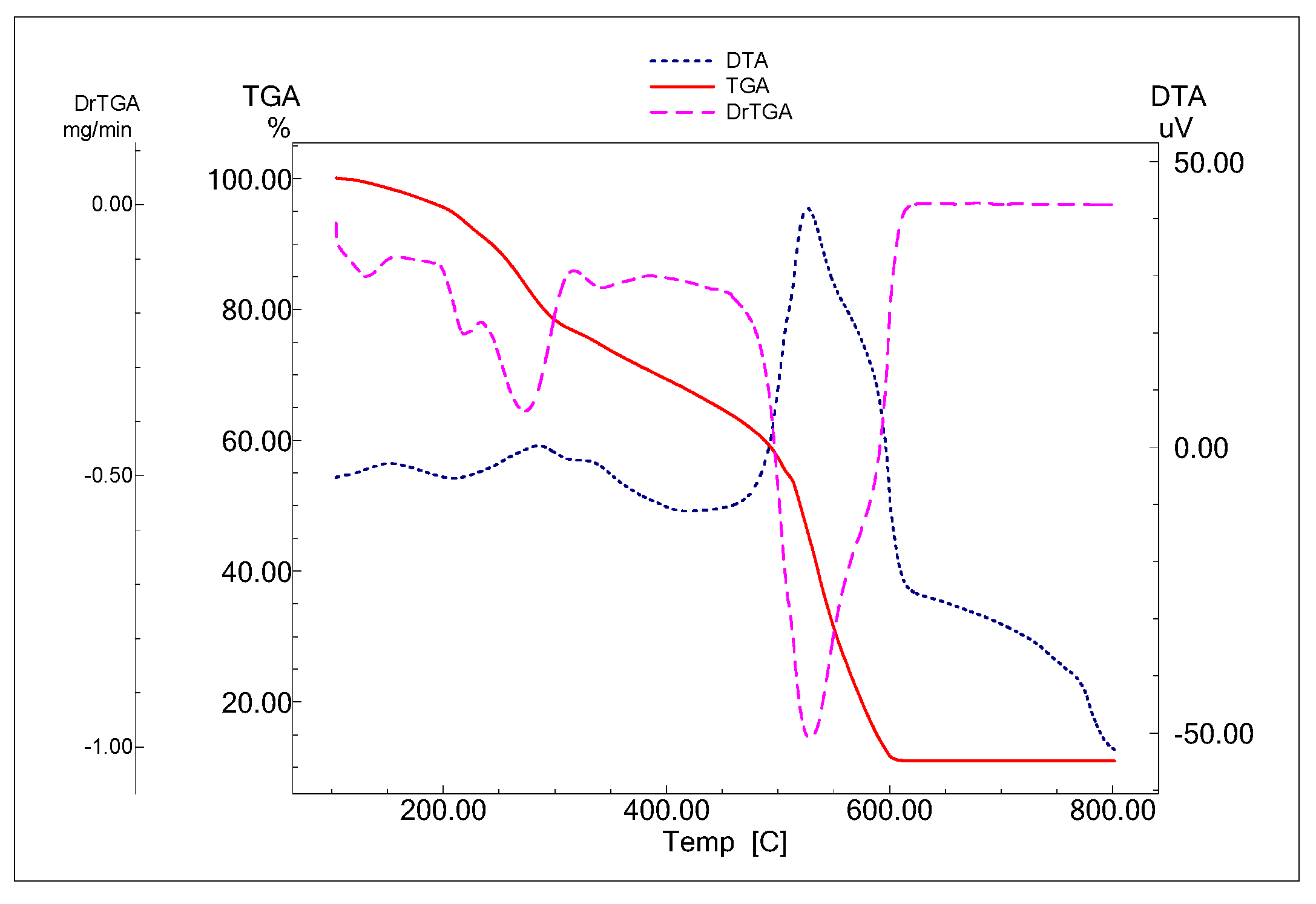

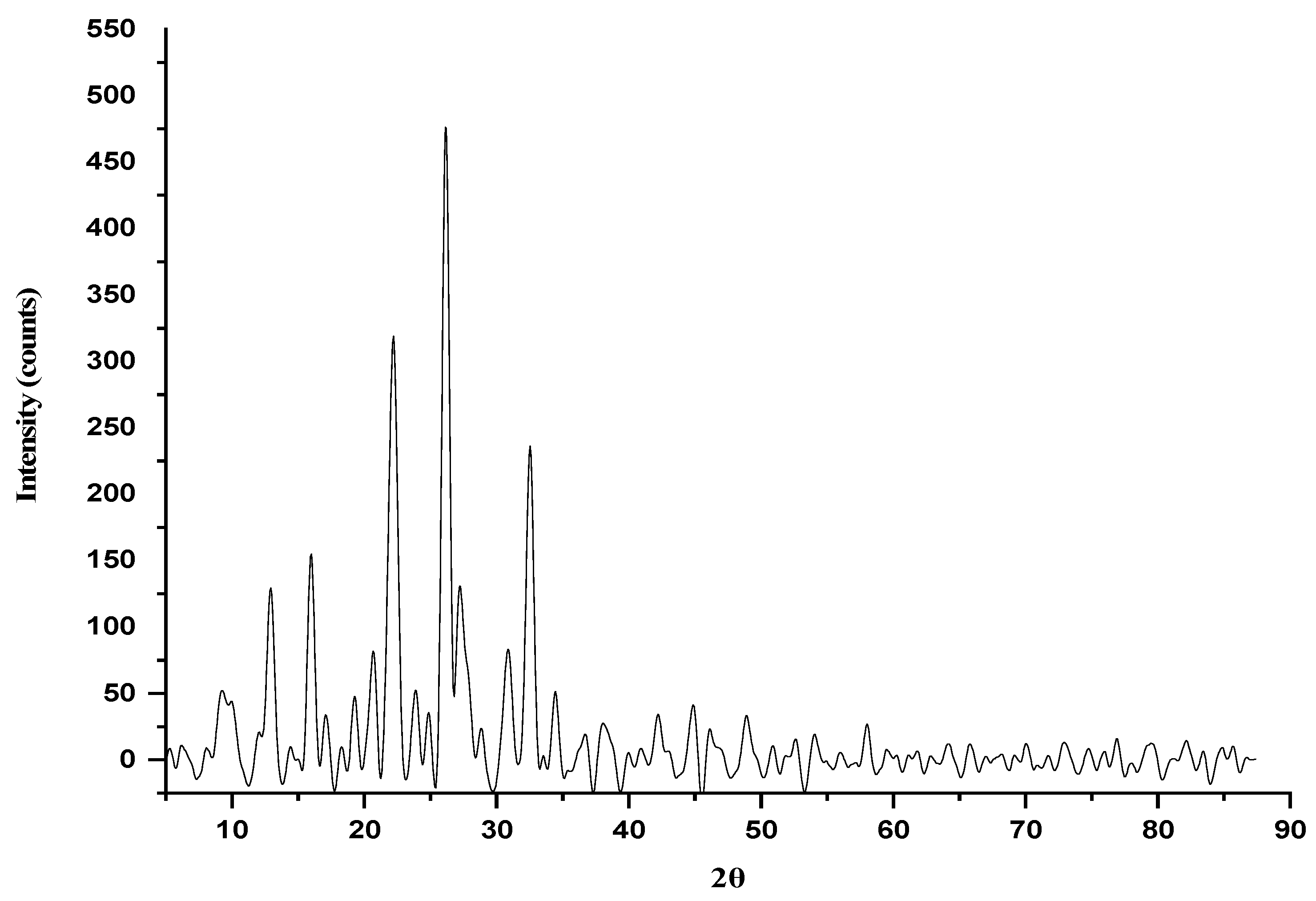

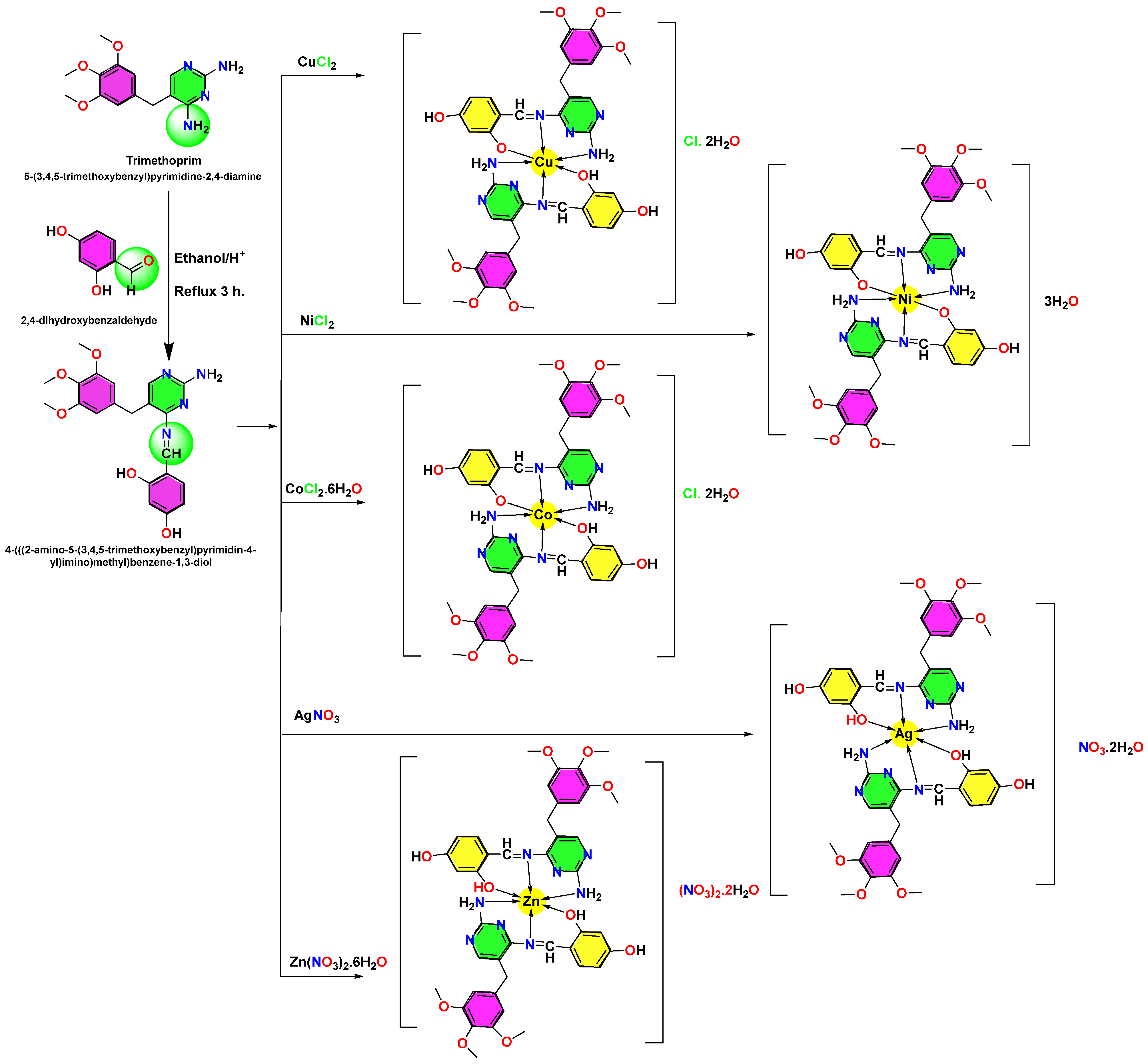
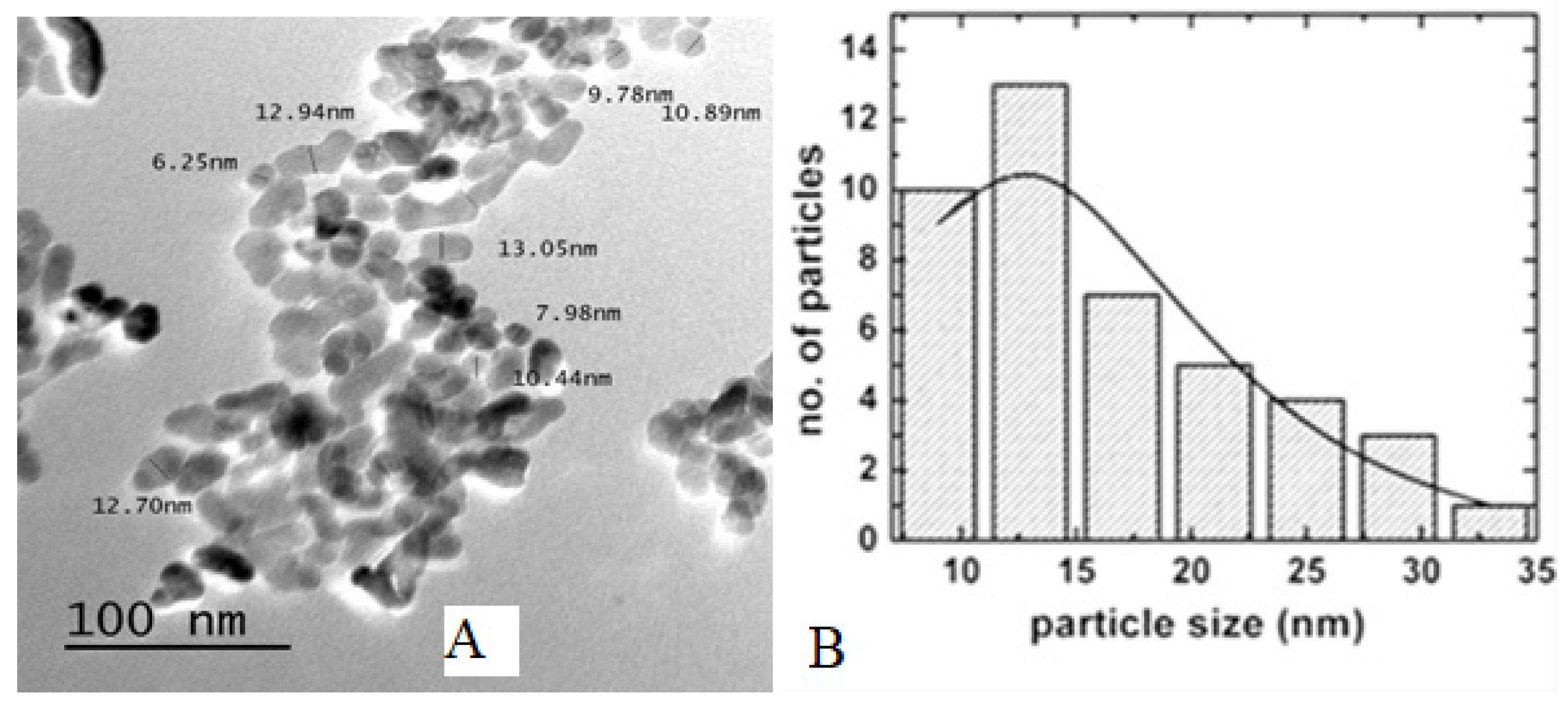

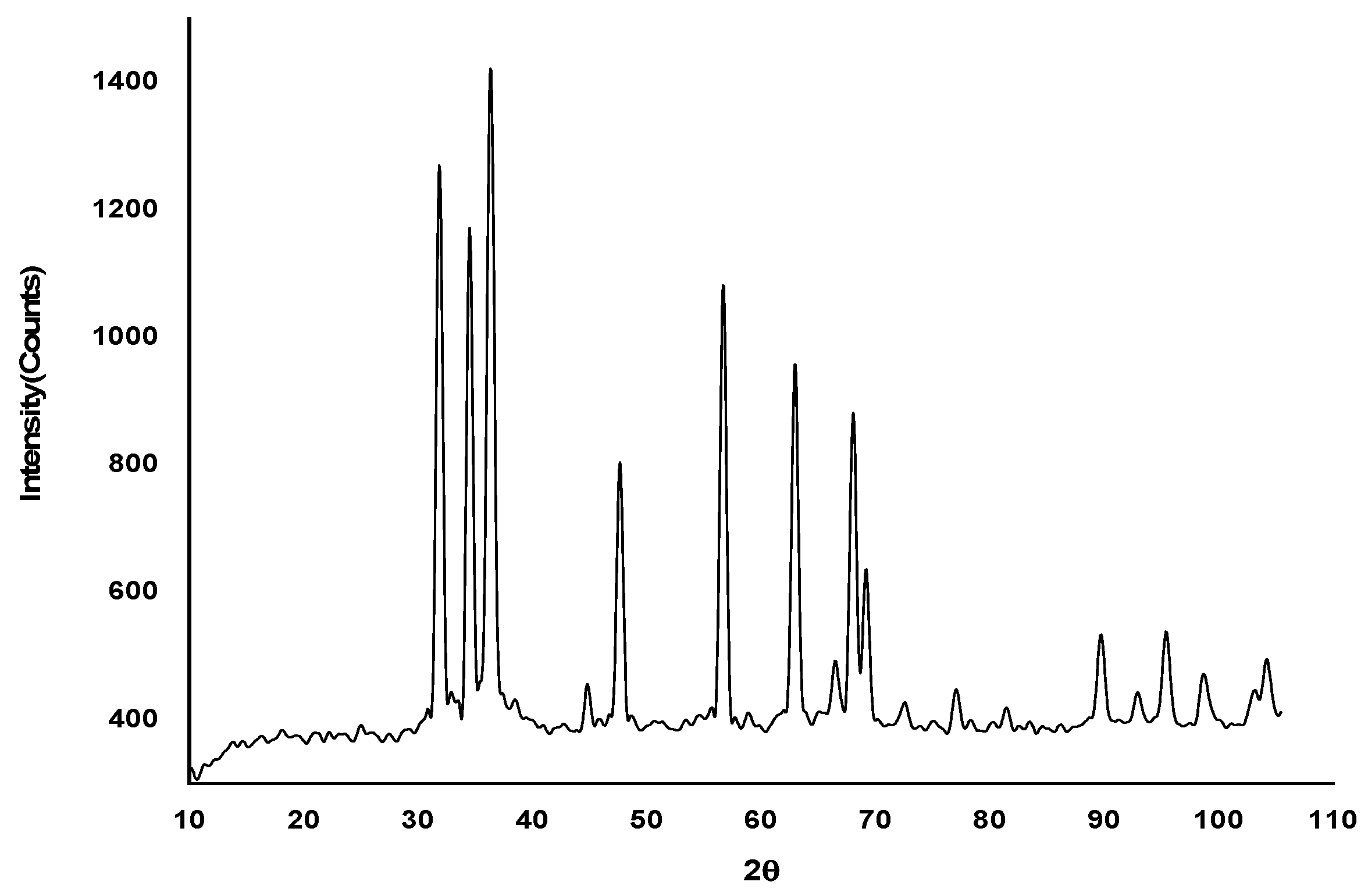
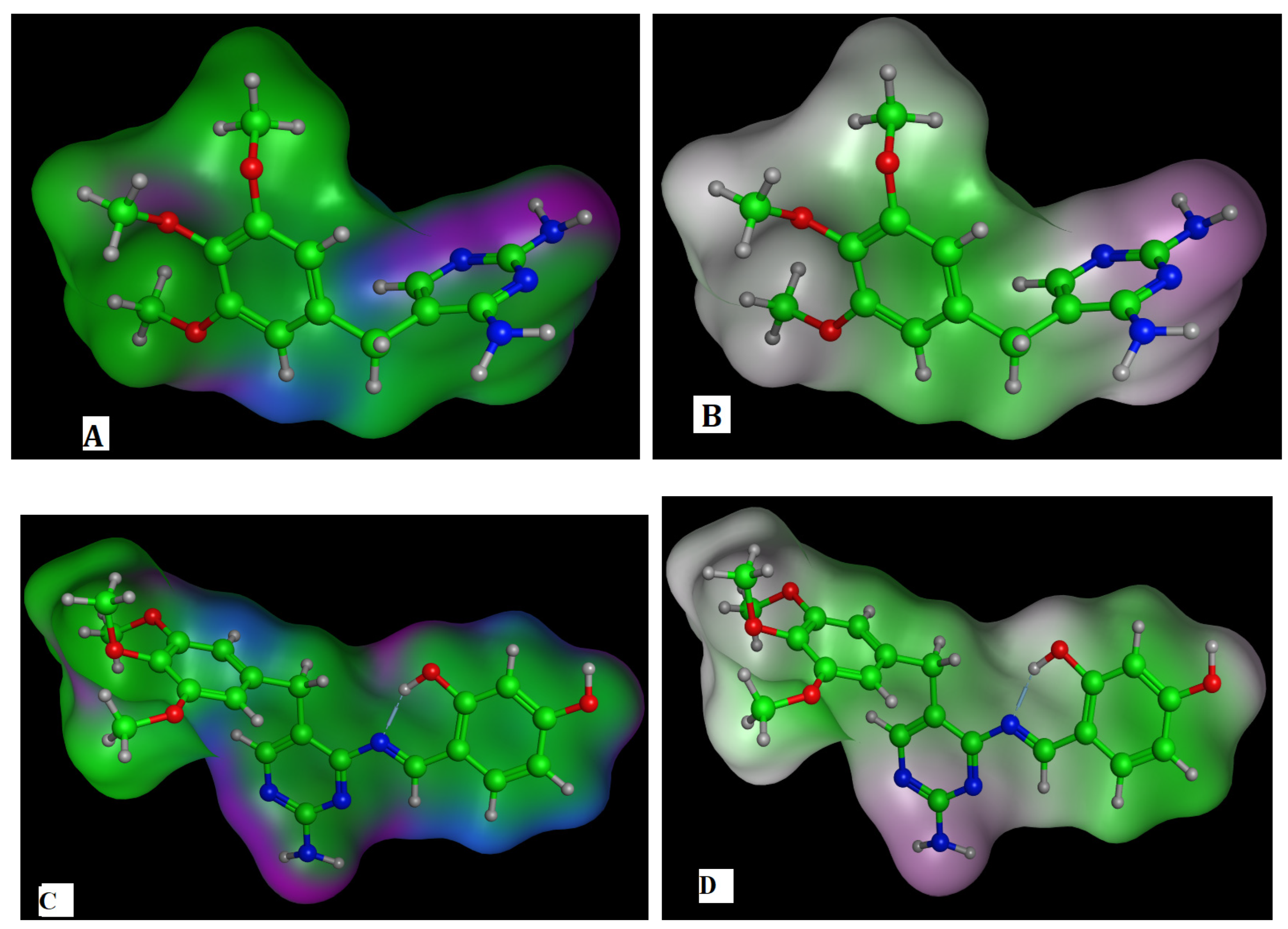
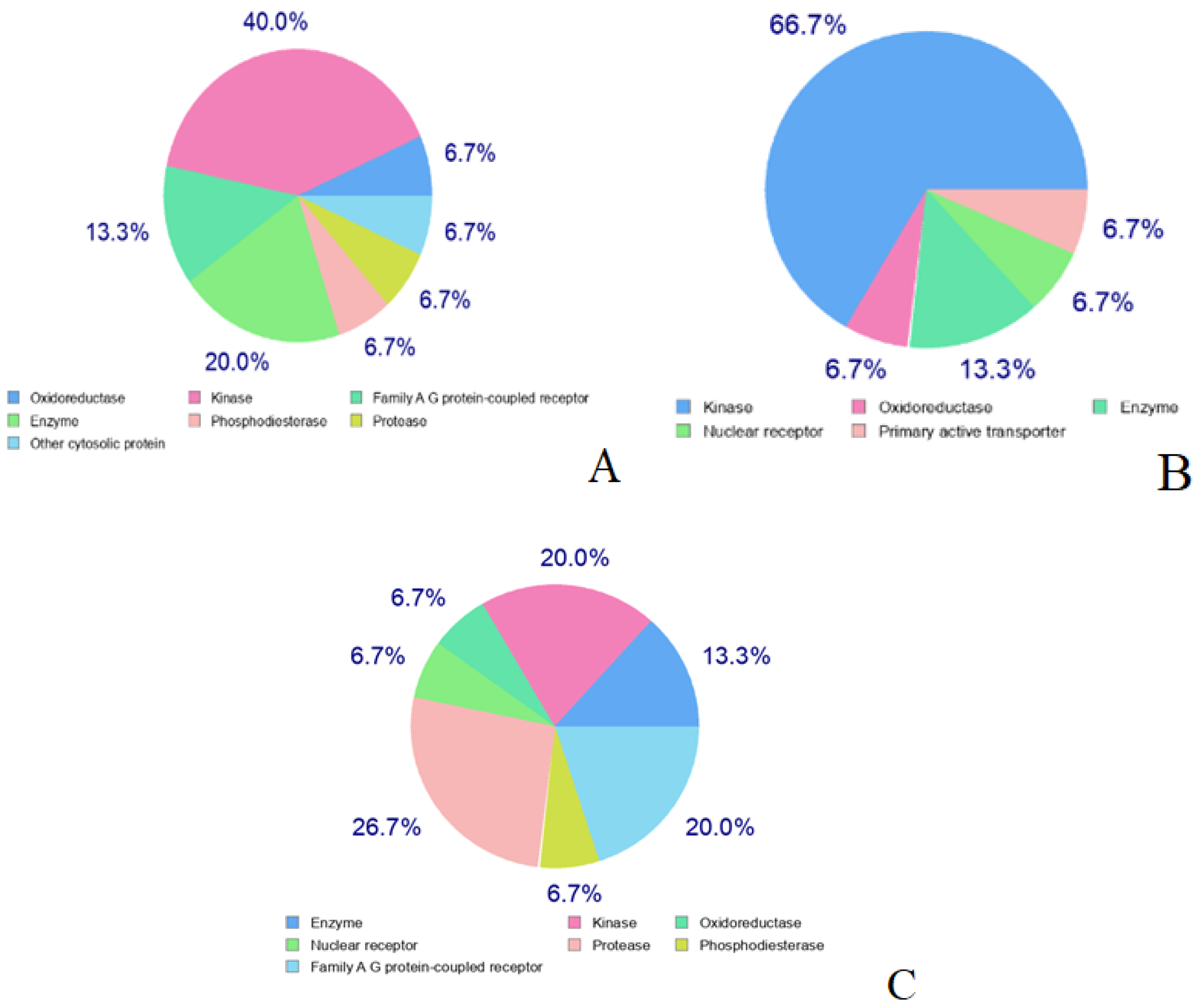
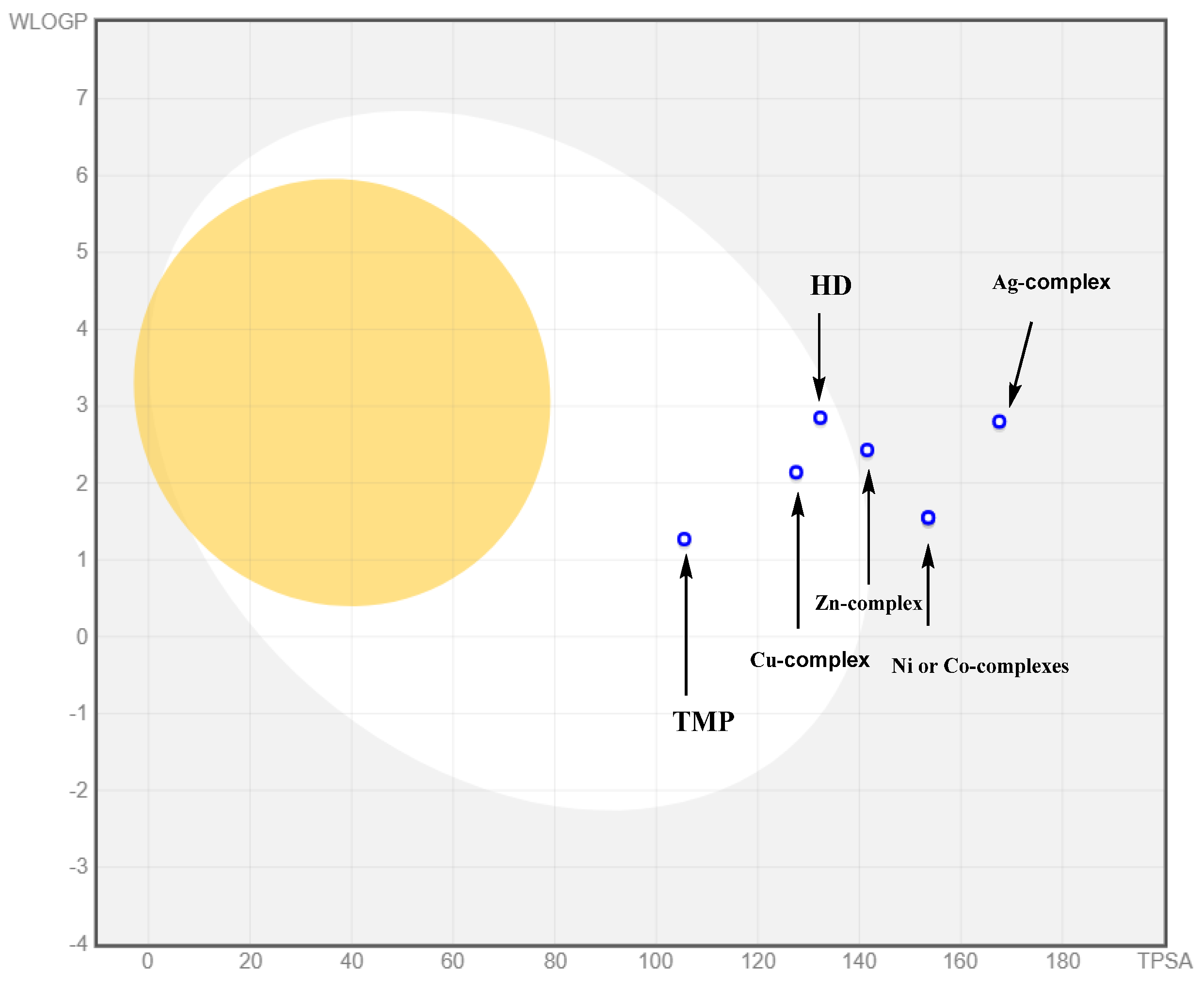
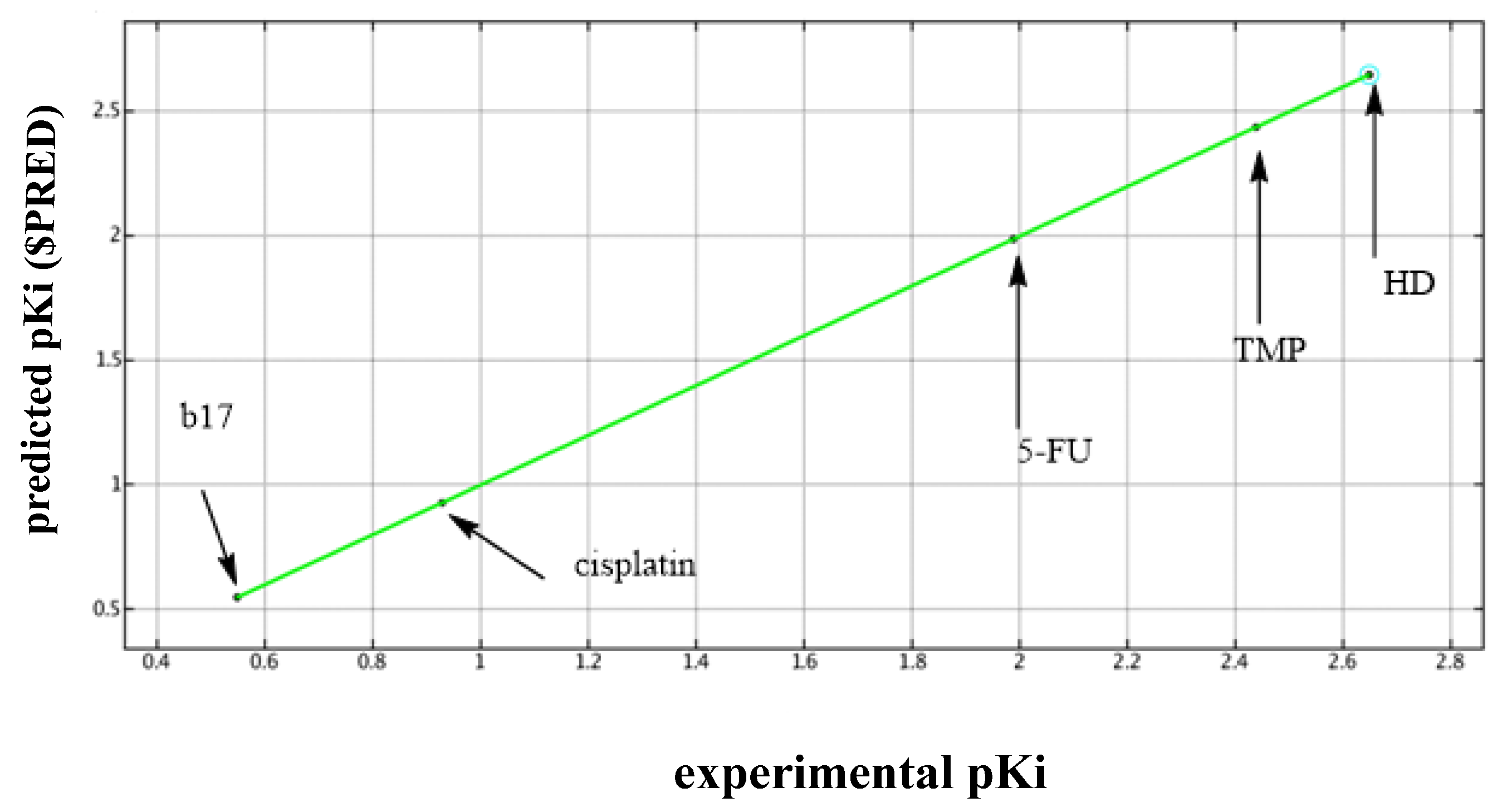

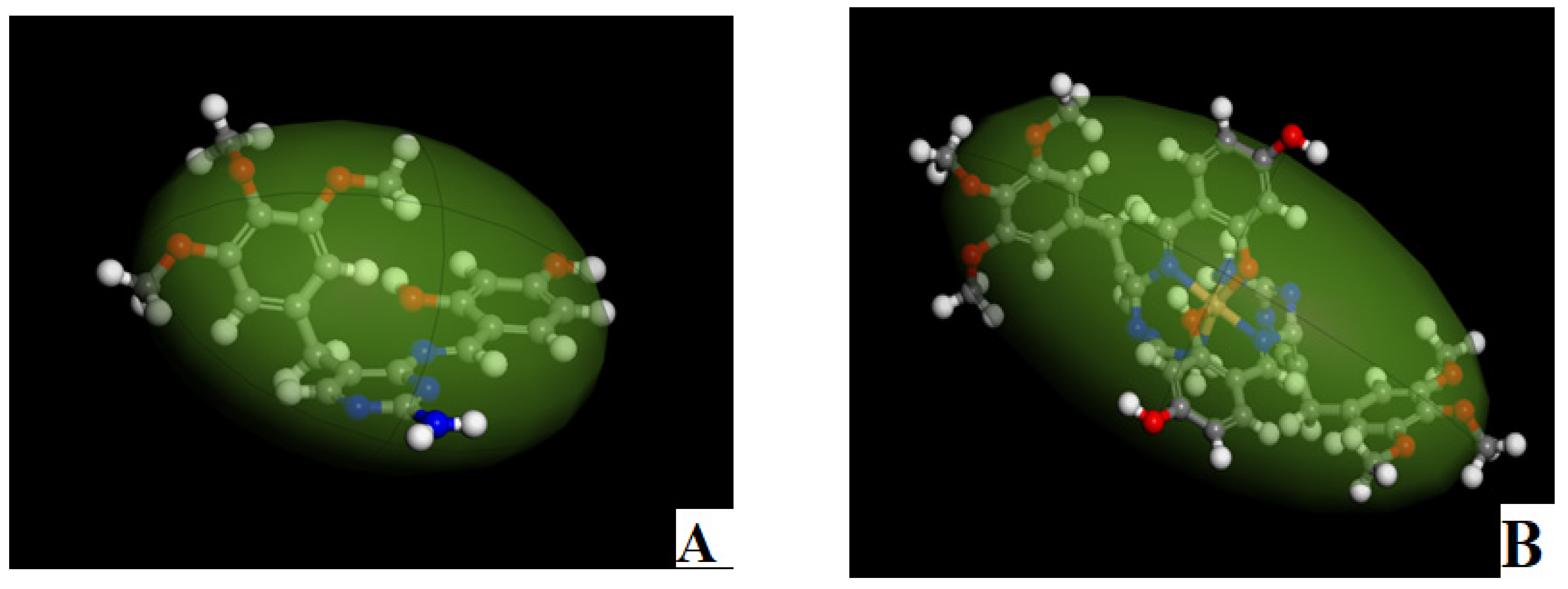

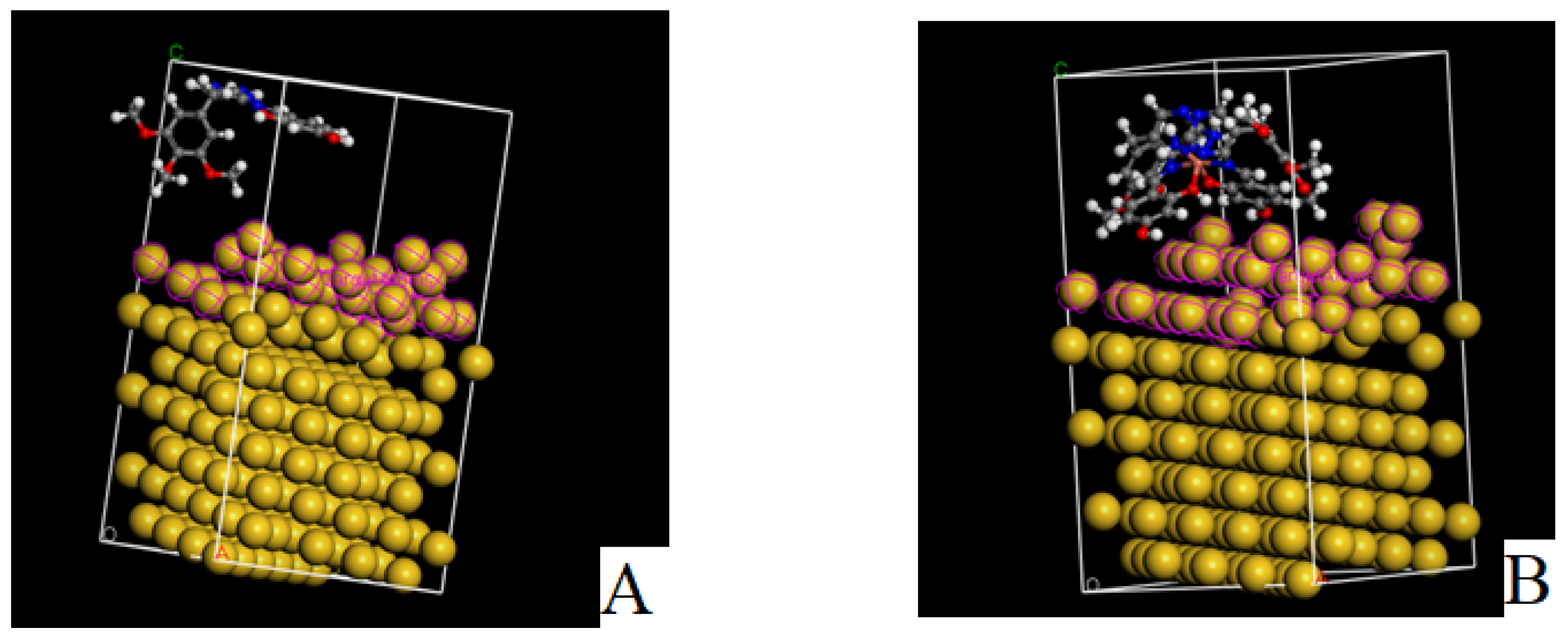
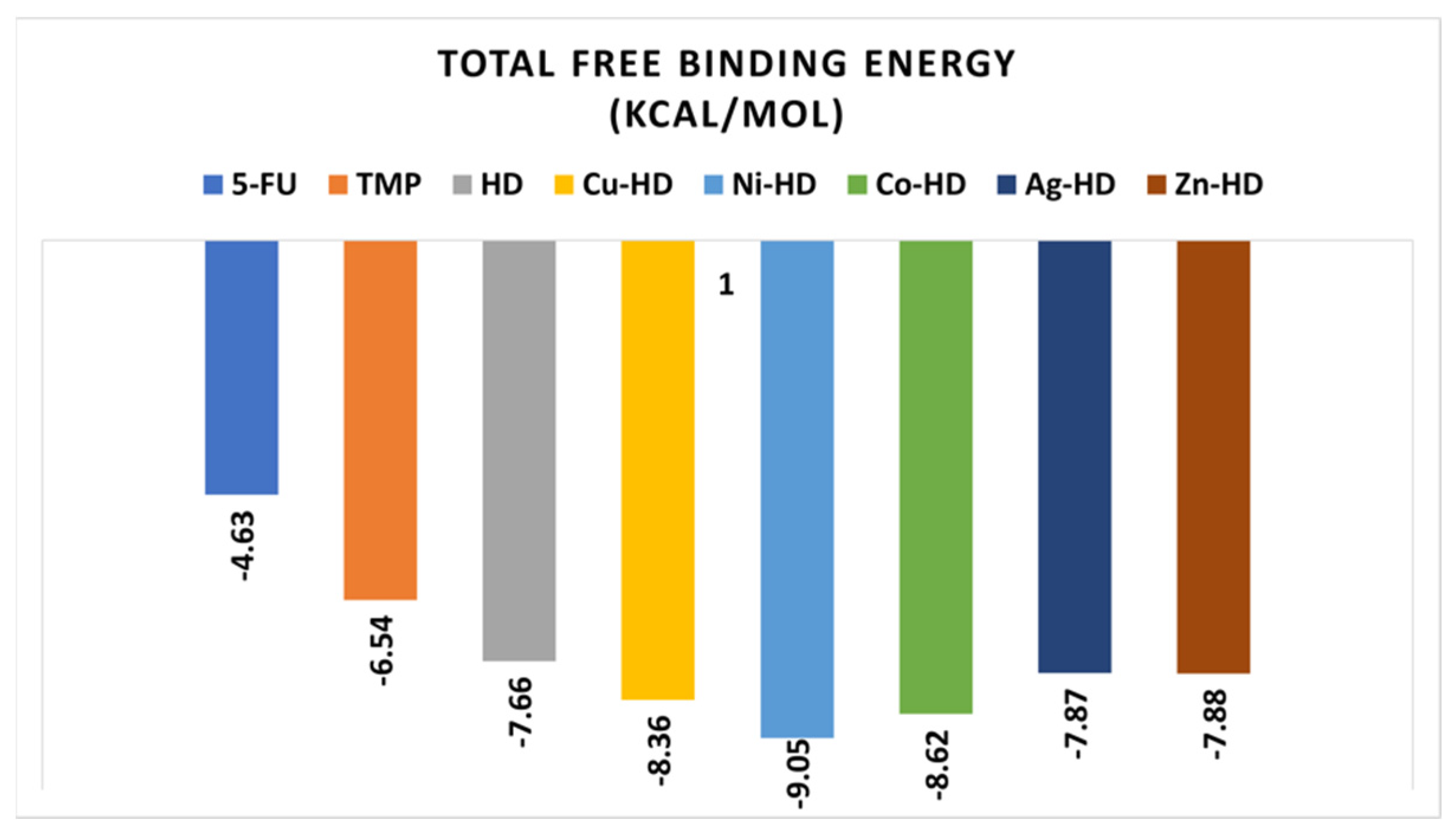
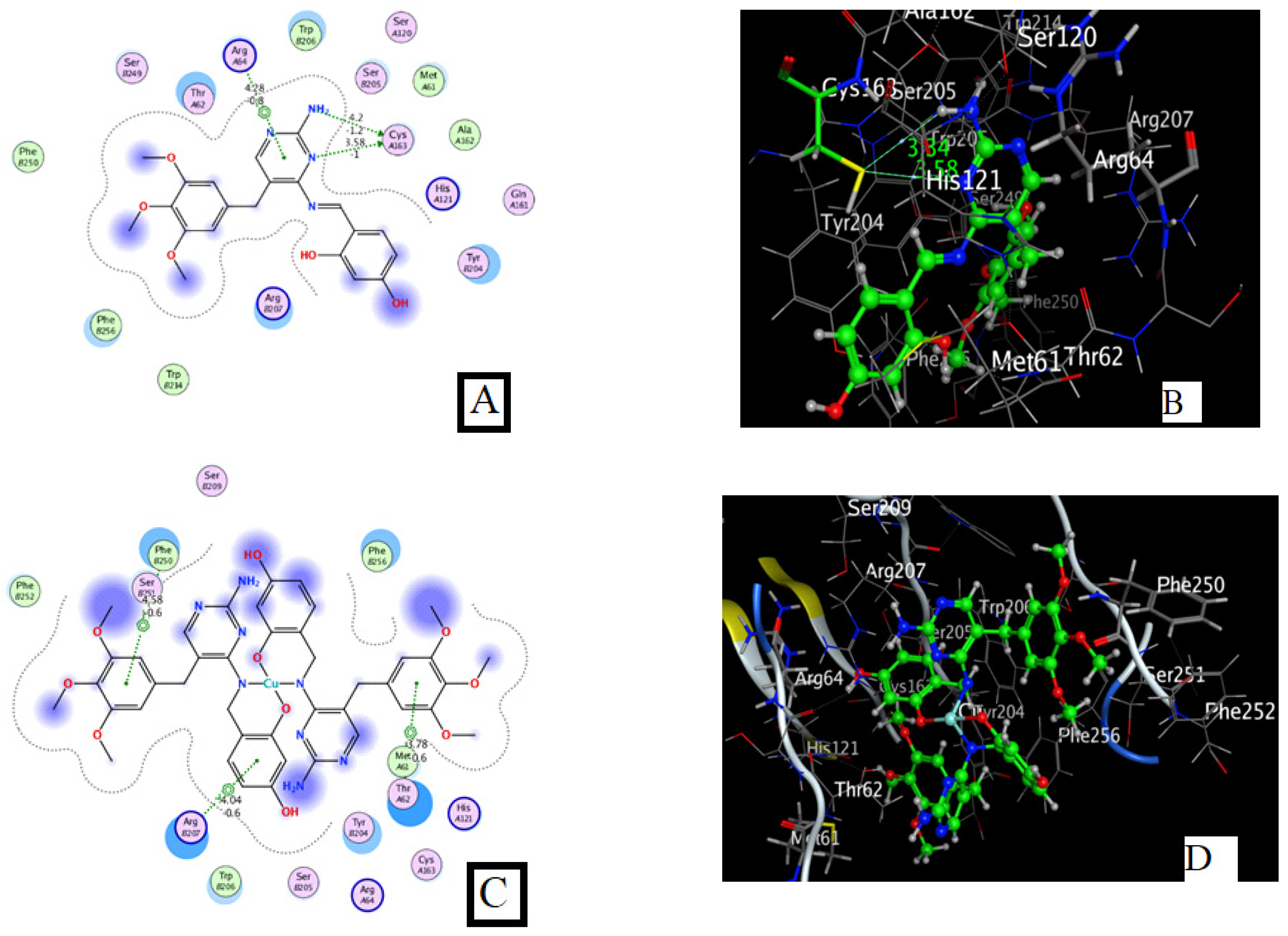
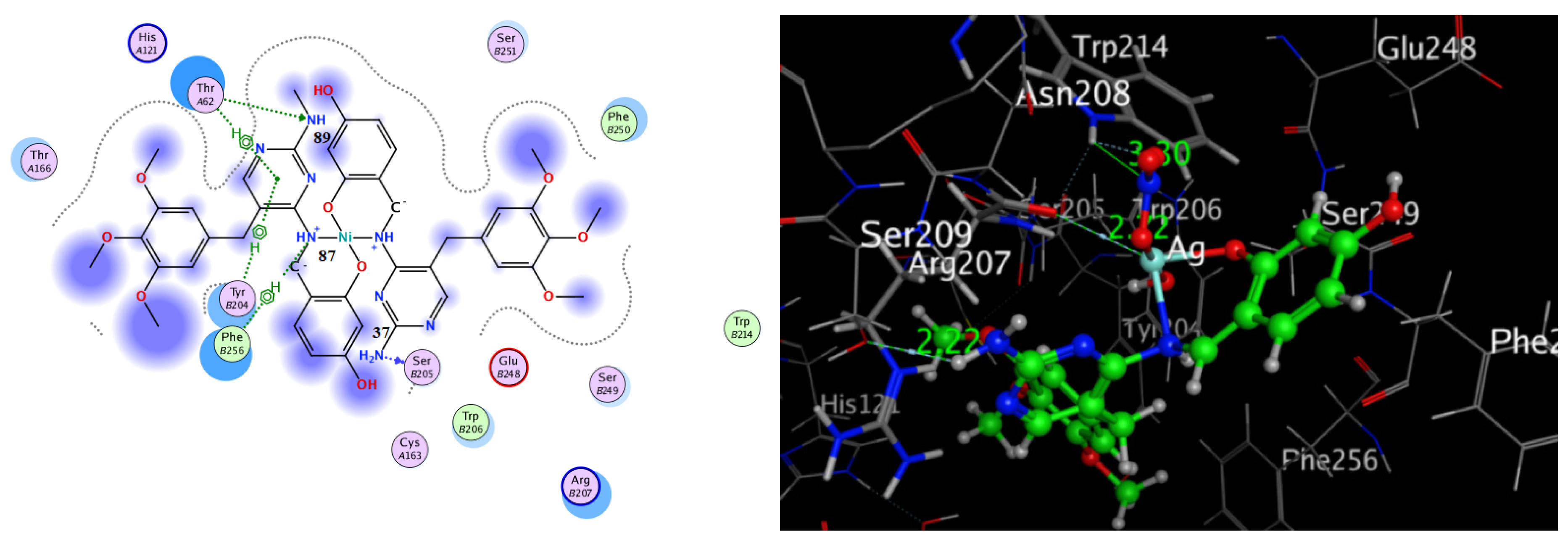
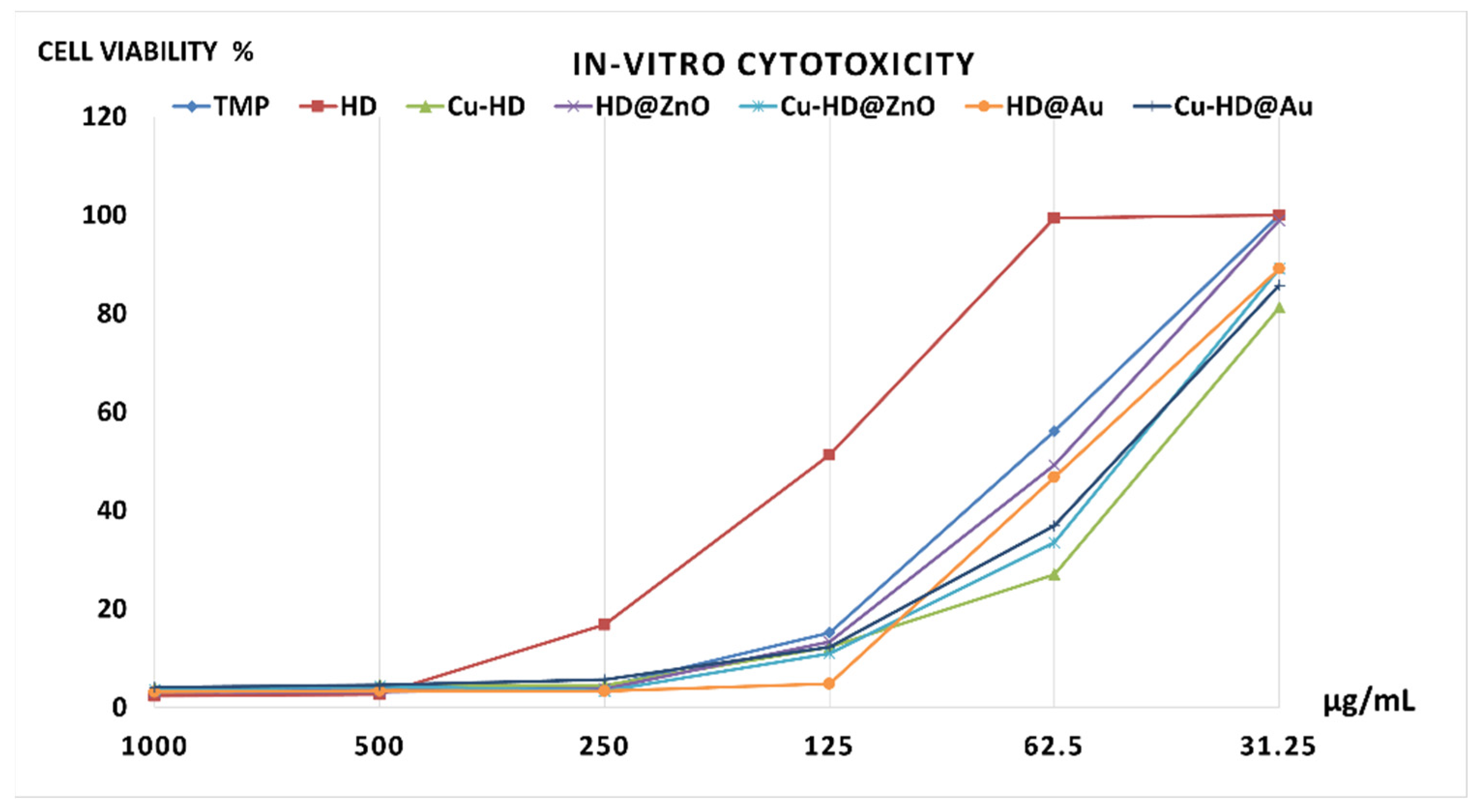
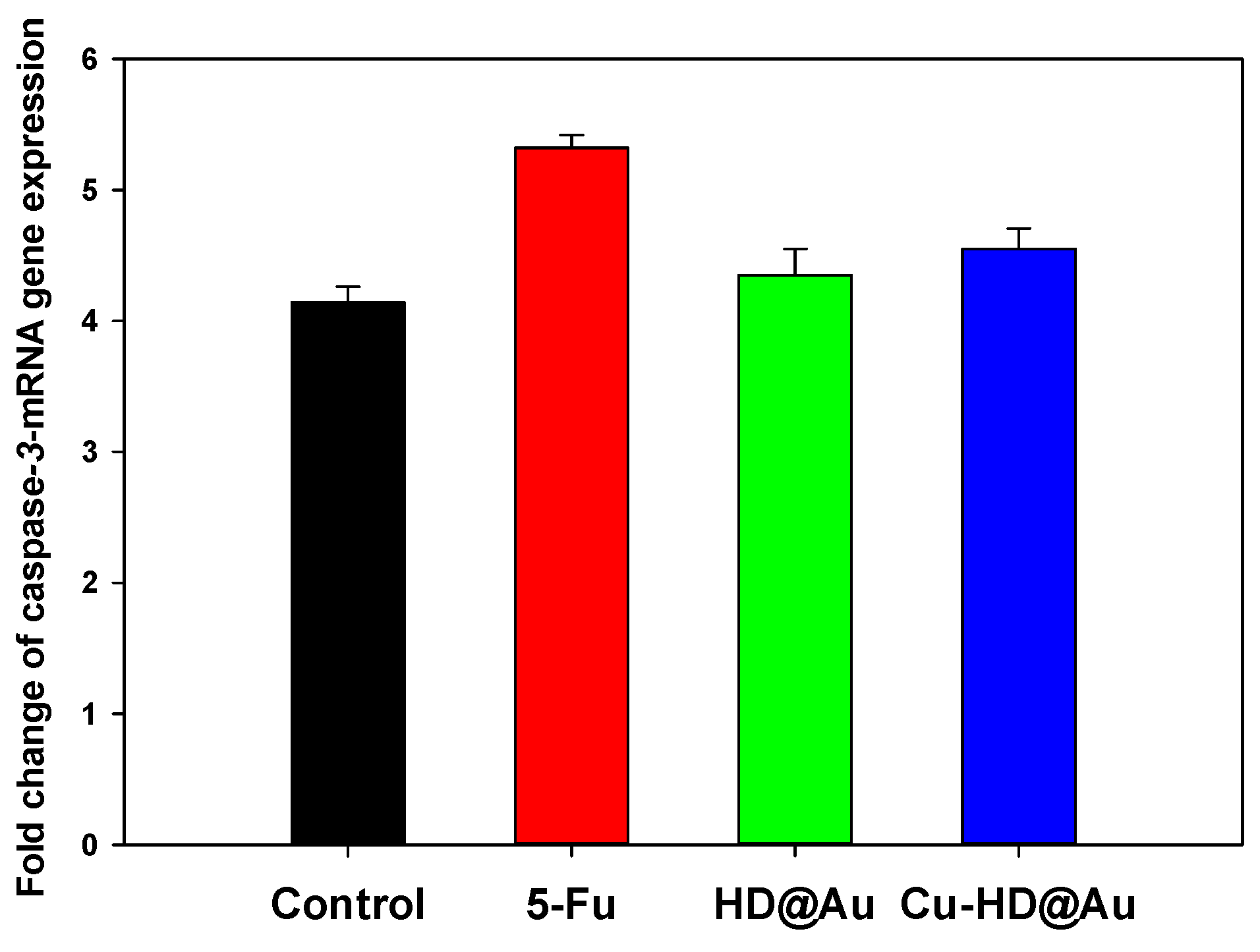
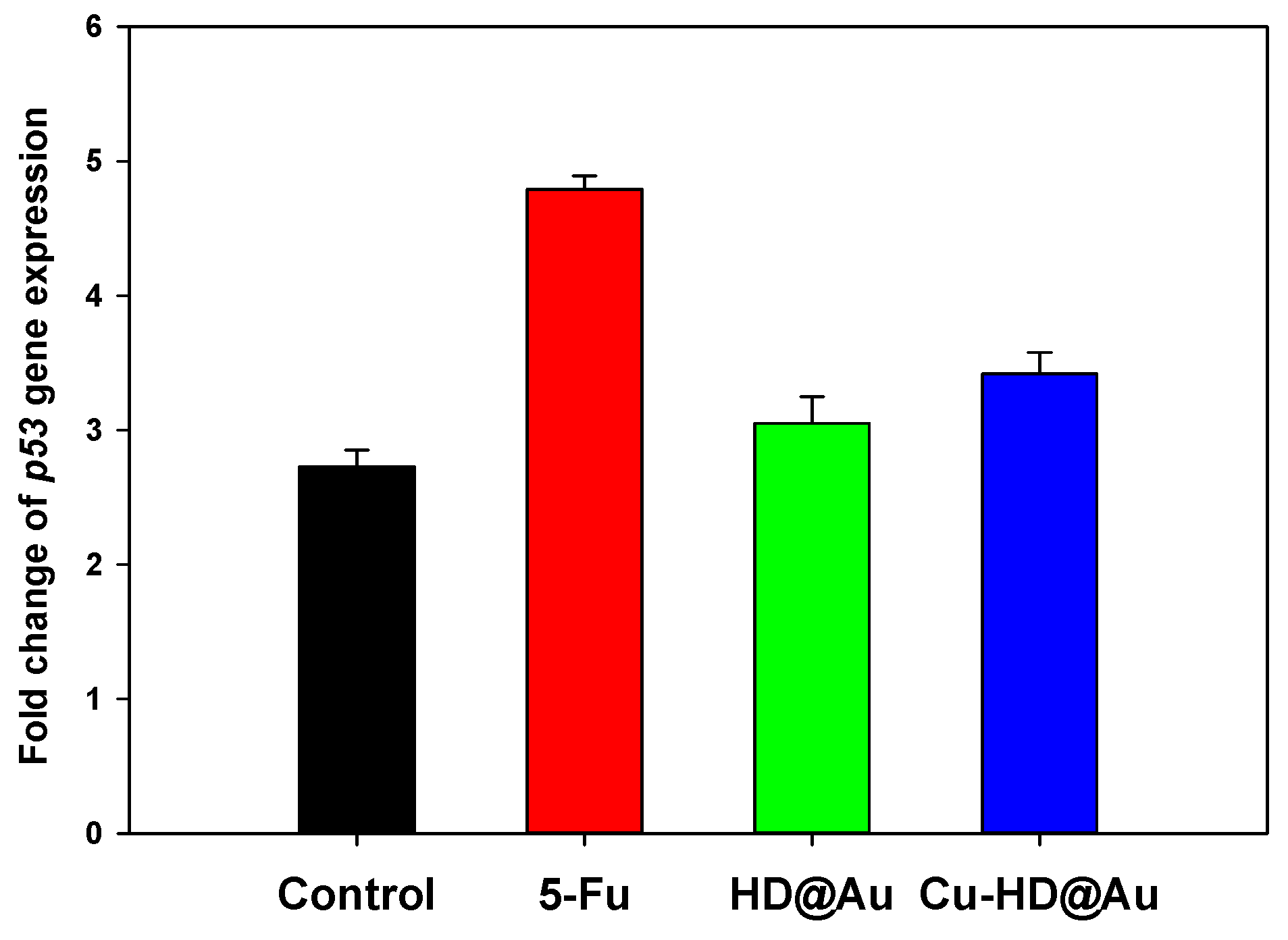

| Compound | Molecular Weight | Color | Melting Point (°C) | Ω * | CHNM% | |||||
|---|---|---|---|---|---|---|---|---|---|---|
| C% | H% | N% | M% ** | |||||||
| Calc. Found | Calc. Found | Calc. Found | A | B | Calc. | |||||
| HD (C21H22N4O5) | 410.44 | Brown | 182 | --- | 61.46 61.42 | 5.40 5.59 | 13.65 13.58 | --- | --- | --- |
| [Cu(HD)2]Cl.2H2O C42H47CuN8O12Cl | 954.88 | Dirty green | >250 | 65 | 52.83 52.23 | 4.96 4.85 | 11.74 11.77 | 6.69 | 7.02 | 6.81 |
| [Ni(HD)2]3H2O C42H49N8NiO13 | 932.59 | Apple green | >250 | 10 | 54.09 54.11 | 5.30 5.25 | 12.02 12.11 | 6.89 | 7.86 | 6.30 |
| [Co(HD)2]Cl.2H2O C42H47ClCoN8O12 | 950.27 | Brick brown | >250 | 68 | 53.09 53.15 | 4.99 5.05 | 11.79 11.85 | 6.69 | 7.59 | 6.20 |
| [Ag(HD)2]NO3.2H2O C42H48 AgN9O14 | 1026.76 | Brick brown | >250 | 60 | 49.13 49.55 | 4.71 4.62 | 12.28 12.35 | 10.25 | 10.95 | 10.50 |
| [Zn(HD)2](NO3)2.2H2O C42H47N10O18Zn | 1045.27 | Yellow-orange | >250 | 130 | 48.26 48.35 | 4.53 4.56 | 13.40 13.45 | 6.86 | 6.78 | 6.24 |
| Property | Model Name | TMP | HD | Cu-HD | Ni-HD | Co-HD | Ag-HD | Zn-HD |
|---|---|---|---|---|---|---|---|---|
| Absorption | Water Solubility (log mol/L) | −2.721 | −4.009 | −2.971 | −2.971 | −2.791 | −2.915 | −2.97 |
| Caco2 permeability (log Papp in 10−6 cm/s) | 0.649 | 0.188 | 0.085 | 0.085 | 0.085 | 0.027 | 0.085 | |
| Intestinal absorption (%) | 76.824 | 78.705 | 70.234 | 70.332 | 70.283 | 64.077 | 69.826 | |
| Skin Permeability (Log Kp) | −2.857 | −2.734 | −2.735 | −2.735 | −2.735 | −2.735 | −2.735 | |
| P-Glycoprotein substrate | Yes | Yes | No | No | No | Yes | No | |
| P-Glycoprotein I inhibitor | No | No | Yes | Yes | Yes | Yes | Yes | |
| P-Glycoprotein II inhibitor | No | Yes | Yes | Yes | Yes | Yes | Yes |
Disclaimer/Publisher’s Note: The statements, opinions and data contained in all publications are solely those of the individual author(s) and contributor(s) and not of MDPI and/or the editor(s). MDPI and/or the editor(s) disclaim responsibility for any injury to people or property resulting from any ideas, methods, instructions or products referred to in the content. |
© 2025 by the authors. Licensee MDPI, Basel, Switzerland. This article is an open access article distributed under the terms and conditions of the Creative Commons Attribution (CC BY) license (https://creativecommons.org/licenses/by/4.0/).
Share and Cite
Abbas, A.M.; Nasrallah, H.H.; Aboelmagd, A.; Boyd, W.C.; Kalil, H.; Orabi, A.S. Novel Trimethoprim-Based Metal Complexes and Nanoparticle Functionalization: Synthesis, Structural Analysis, and Anticancer Properties. Inorganics 2025, 13, 144. https://doi.org/10.3390/inorganics13050144
Abbas AM, Nasrallah HH, Aboelmagd A, Boyd WC, Kalil H, Orabi AS. Novel Trimethoprim-Based Metal Complexes and Nanoparticle Functionalization: Synthesis, Structural Analysis, and Anticancer Properties. Inorganics. 2025; 13(5):144. https://doi.org/10.3390/inorganics13050144
Chicago/Turabian StyleAbbas, Abbas M., Hossam H. Nasrallah, A. Aboelmagd, W. Christopher Boyd, Haitham Kalil, and Adel S. Orabi. 2025. "Novel Trimethoprim-Based Metal Complexes and Nanoparticle Functionalization: Synthesis, Structural Analysis, and Anticancer Properties" Inorganics 13, no. 5: 144. https://doi.org/10.3390/inorganics13050144
APA StyleAbbas, A. M., Nasrallah, H. H., Aboelmagd, A., Boyd, W. C., Kalil, H., & Orabi, A. S. (2025). Novel Trimethoprim-Based Metal Complexes and Nanoparticle Functionalization: Synthesis, Structural Analysis, and Anticancer Properties. Inorganics, 13(5), 144. https://doi.org/10.3390/inorganics13050144










